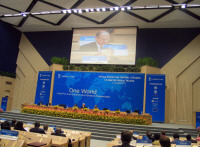



Delegates Pledge $605 Million in New Delhi for Avian Flu Fight
NEW DELHI - Eight nations and the European Commission pledged $605 million December 6 in the continuing fight against the spread of H5N1 avian influenza in birds and people for efforts focusing on halting the virus at its avian source, bolstering disease surveillance and integrating animal and human health services and capabilities. |
| U.S. Ambassador John Lange, on screen, pledges $195 million in aid for avian and pandemic flu December 6. (Cheryl Pellerin/State Dept.) |
New Delhi - Eight nations and the European Commission pledged $605 million December 6 in the continuing fight against the spread of H5N1 avian influenza in birds and people for efforts focusing on halting the virus at its avian source, bolstering disease surveillance and integrating animal and human health services and capabilities.
Many delegates, including those from the United States, also emphasized the importance of using nonpharmaceutical interventions such as social distancing to help limit the impact of a pandemic in the first six months, before a specific vaccine is available.
The pledges came on the final day of the December 4-6 New Delhi Ministerial Conference on Avian and Pandemic Influenza, hosted by the government of India in collaboration with the International Partnership on Avian and Pandemic Influenza, launched by President Bush in 2005. (See fact sheet.)
“On behalf of the United States government,” Ambassador John Lange, head of the U.S. delegation and special representative for avian and pandemic influenza at the State Department, told the delegates, “I’m pleased to announce our new pledge of international assistance for avian and pandemic influenza, through the U.S. Agency for International Development, the Department of Health and Human Services and the Department of Agriculture in the amount of $195 million.”
The funds, which bring the cumulative U.S. pledge since 2005 to $629 million, will support the efforts of international organizations, nongovernmental groups and others to strengthen global preparedness and response to avian flu and a potential human flu pandemic. Some of the resources will support India’s surveillance program for animal and human disease.
More Than Money
In addition to the United States, delegates from the following nations announced pledges: European Commission, $116 million; Japan, $69 million; United Kingdom, $10 million; France, $7.5 million; Germany, $4.3 million; India, $2 million; Norway, $1.75 million; and Greece $441,000.
The New Delhi ministerial is the sixth international avian and pandemic flu gathering, some of which were donor meetings that together generated more than $2.3 billion in pledges.
A vendor sits with his chickens at a market in New Delhi in 2006. (© AP Images)“We were still looking for about another $1.2 [billion at the Delhi meeting] and we have raised something of $400 million today,” said Peter Harrold, director of Operations Policy and Country Services at the World Bank. “There, of course, still remain -- there will always remain -- financing gaps. But the mobilization of resources remains incredibly impressive.”
To those who questioned the decrease in pledges since the 2006 Bamako (Mali) International Conference on Avian Influenza -- from about $474 million there to $405 million in New Delhi -- Harrold said, “We did not enter this meeting with a target for additional financing. We entered the meeting to gather together something which is at least as valuable as money -- that is the knowledge and experience that has been accumulated in the many countries that are fighting this disease.”
“The pledges are valuable additional infusions to sustain the energy of what is proving to be an epic process of building our capacity globally,” said Dr. David Nabarro, U.N. system coordinator for avian and pandemic influenza, “but we are also looking for longer-term commitments to improved animal health and human health security beyond the kind of pledgings done at this conference, and to longer-term development assistance in these areas.”
Moving Target
Despite the funding gaps, real progress has been made over the last few years, delegates reported throughout the meeting. More than 90 percent of countries report they have developed pandemic preparedness plans, there is circumstantial evidence that the spread of H5N1 is slowing and global human flu virus diagnostic and surveillance capacity has improved.
On the other hand, H5N1 is considered enzootic (prevalent in an area) in locations in at least six countries, veterinary capacity in many countries is insufficient and there is not enough coordination between animal and human health surveillance and response networks in most regions.
“Countries are much better prepared now than they were a year ago for a pandemic, however the preparedness is not as broad or deep as we would like it to be,” Nabarro said. “Although some countries have tested their preparedness with exercises -- including India -- there is still more testing to be done. Because when the pandemic does come, it will be too late to prepare.”
The three-day meeting drew an unprecedented 750 delegates and 40 government ministers from 111 nations and 29 international organizations. For the first time at an avian influenza meeting, the directors-general of three top U.N. agencies -- the World Health Organization, the Food and Agriculture Organization and the World Organisation for Animal Health -- were in attendance.
Indian Prime Minister Manmohan Singh addressed delegates December 5, warning against disconnections between animal and human health.
“Investments in public health will be unproductive without ensuring the health of our livestock,” he said. “Our budgetary policies must match the effort, with adequate funding of animal health programs, along with funding for human health. The government of India supports the concept of One Health, [which is] based on an integrated approach to animal and human health.”
Further Reading
|
|
- View our Avian Flu information page by clicking here. |








